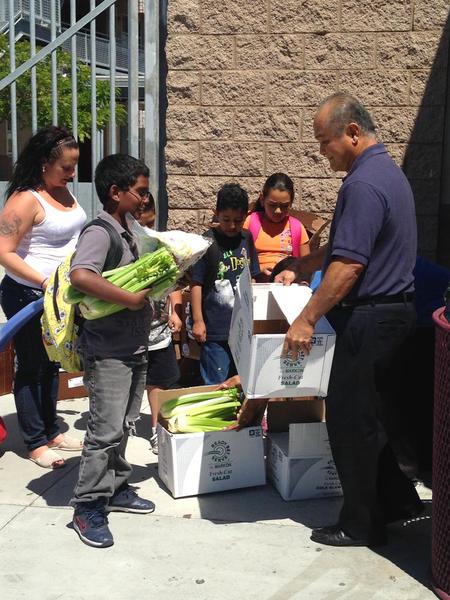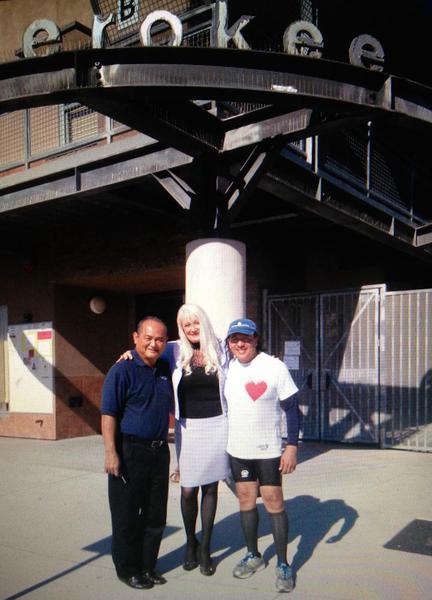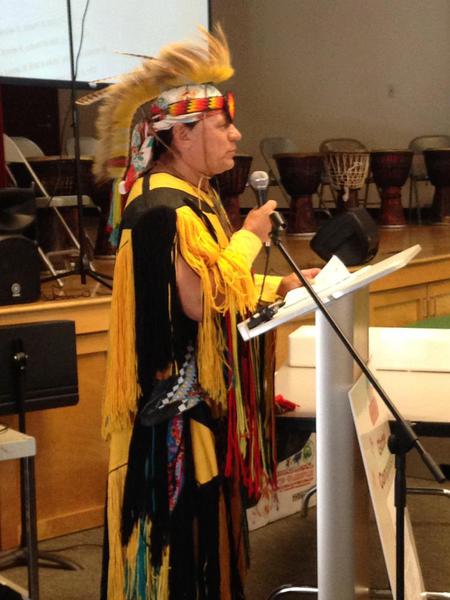I want to tell you about Cherokee Point Elementary, my visit there and a best practices school model that I witnessed in action and strongly believe should be copied and emulated nationally.
[At left: Principal Godwin Higa and Cherokee Point Elementary feed the community.]
Cherokee does not talk about the importance of community/school engagement; it lives it. Our children learn more through what they see modeled than from what they hear or are told!
Every other Friday, the school distributes 4,000 pounds of fruits and vegetables to the community. During the Academic Saturday school program that is held every Saturday morning and was developed for students in need of academic support, they also convene parenting classes.
Apart from the food bank they have also had events such as the Food 4 Kids Program – 75 backpacks that provided students free food in a backpack every Friday for the weekend. In 2013 they started a PreK student assessment team that is now on campus to assist parents with children with disabilities. They have teamed up with the Copley YMCA to offer swimming lessons. Through their parent education they offer domestic violence training and other legal and health services, such as, Immigration Rights.
They participate in the local police district's monthly curfew sweeps - where they can identify and provide community members access to necessary community services.
They've held regular community town hall meetings at the school, including meetings that featured the mayor and the local district's Commission on Gang Prevention & Intervention.
During his monthly principal’s chat, Higa brings in other community and support agencies.
Cherokee is more than a school it is the center and heart of the community. Doing a great deal of work to keep that heart beating is another incredible individual, Dana Brown. Brown works with the students and runs a youth leadership program. She also is involved in supporting much of the community work I’ve written about that Cherokee is involved in. Apart from participating in the curfew sweeps and community town hall meetings, she is a critical and integral part of advancing Cherokee’s community service model.
[At left: Dana Brown and Principal Higa with me.]
While I was at Cherokee, she introduced me to members of one of the groups that she works with in bringing leadership and support into the community, students from San Diego State University.
I’m sorry to not have been able to stay a few more days for the “Youth Leaders at the Live Well, San Diego Summit”. I know that Dana will write a piece about the summit for ACEsConnection, share the incredible experience that the children had at the summit, and what was accomplished by the youth leaders through sharing their voices and stories.
What I did witness and can share is the Community Global Compassion Conference that was held at the school.
At left, a fifth-grade student reads her essay on compassion in Spanish as translator reads it in English. The student said, “Having compassion is caring, understanding and helping others. It is knowing a person and not judging, but helping that person with what they need.”
The opening ceremony was given by a representative of the Native American community, who shared with us that we are one people and must love one another.
[Below, children participate in drum circle.]
A young engineering student from San Diego State University spoke to us about Islam and how the true meaning of Islam is love. She shared a story about the prophet: A woman put garbage in a basket, and threw all the garbage on the prophet Muhammad when he passed by. Much to the woman's disappointment, he did not say anything and continued on his way. She did the same the following day thinking, "Maybe this time I will be able to annoy him." But he was too gentle to shout at the woman. She did this day after day. One day, the Holy Prophet Muhammad did not find the woman to be on the roof of her house with the basket. This worried him, because he thought something must have happened to her for not being over there. So he knocked at the door. "Who is it?" asked a feeble voice. "Muhammad bin Abdullah," was the reply, "can I come in?" The woman feared, "I am sick, and too weak to fight or talk back, therefore Muhammad has come to take revenge for what I have been doing to him." But the permission to enter her house was in such a gentle voice that she allowed him in. Muhammad entered the house and told the woman that not finding her on the roof had worried him and he thus wanted to inquire about her health. On finding out how ill she was, he gently asked if she needed any help. She asked for some water. He kindly gave her some and prayed for her health, while she quenched her thirst. This made her feel very guilty for being so cruel to him in the past and she apologized for her mean behavior. He forgave her and came to her house everyday to clean it, to feed her and to pray for her, till she was on her feet again.
As the conference was taking place Higa, Brown, and other volunteers passed out food to the community. I leave you with images of the food that was being distributed and a question: What would our schools and communities be like if all our children were having this experience?









Comments (0)